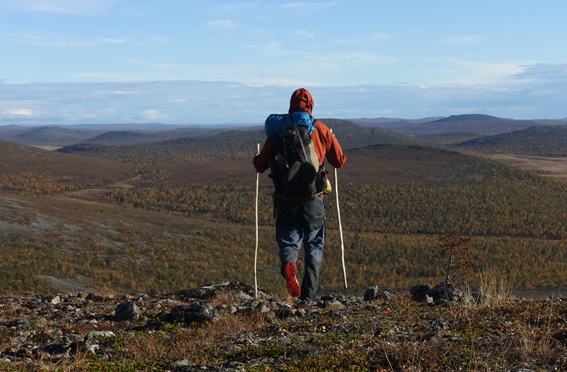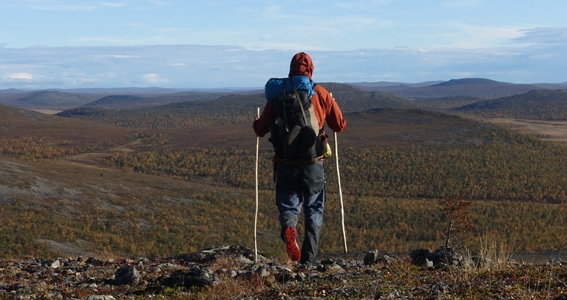Jouni Laaksonen 12.10.2020
In my earlier post I gave glimpses of my five week hike. I started in warm, green summer in the middle of August in Kemihaara, southern end of Urho Kekkonen National Park. I walked across five large wildernesses: Urho Kekkonen NP, Hammastunturi Wilderness Area, Lemmenjoki NP, Muotkatunturit WA, and the area that consists of Kevo Strict Nature Reserve and Paistunturit WA.
I ended my journey deep in autumn in the northernmost municipality in Finland, Utsjoki. During the last two weeks all the leaves were magnificent yellow, orange and red. During the hike I saw the first aurora borealis this year, and experienced the first morning frosts.

I did not walk straightforward, and this is not a route I recommend for anyone else. I planned this route just for me, for I have hiked almost all the marked hiking trails and other popular paths, and a lot outside these in Finnish Lapland. Now I wanted to see certain particular surprising viewpoints, not generally known gorges, less known historic sights and so on, and I planned a very twisty route.
Off trail hiking
There’s a huge difference between hiking on trail vs off trail. On trail walking is a lot easier and quicker, and thoughts can fly freely. Navigating is very easy, and there are frequently huts and lean-tos.
Hiking along a trail in is easy. The path is wide and marked, there are duckboards, bridges and stairs, there are huts and campfire sites with dry firewood provided. And there are quite a lot of other hikers, too.
Hiking off trail is a task and a blessing. There are super easy forests and fells to walk through, but also annoying thickets of dwarf birch, rocky areas, rivers to wade over and so on. The great joy is that you can all the time choose your own way, and if you find yourself in the middle of a wet bog there’s no one else to blame than yourself. 🙂 There are no signposts and no facilities – and no fellow hikers.
Off trail hiking is more demanding, both orienteering and terrain wise. You have to concentrate all the time. But the benefits are great, too. I walked over 600 km in 32 days, and I saw about 160 other hikers. Almost all of them I saw when I walked for short stretches on trails near popular places like Kiilopää, Lemmenjoki and Kevo. Off trails and huts I saw only 6 hikers, and BTW, these were all interesting characters.
On trails I saw almost no wildlife (I’m not counting reindeer, since them you see so often, both on trails and off), but off trails I saw over 50 willow grouses, twenty wood or black grouses, dozens of swans, some hawks, some lemmings, a moose, one wolf dropping, seven brown bear droppings… And I saw those new sights I had wanted to see, and got a dozen new favourite places. 🙂

With a pocket camera I could not get a decent picture out of any bird I saw. However, this large moose antler was easy to photograph.
In my opinion hiking off trail is very Finnish way of hiking. Of course most Finns hike along marked trails, and that’s good. But still the tradition of planning your own route through pathless forests and fells, lighting a small fire to prepare your dinner, and pitching your tent just where you wish to camp is strong.
I hiked solo for first four weeks. The last week I walked with two friends. For some people being alone does not suit. For some, like me, it suits very well. If you are planning to hike solo, start with small steps and make sure you like it. There’s also safety to consider! There’s much more about solo hiking here.
About food, water and gear
I selected lightweight equipment, but did not aim to ultra-light. I acquired more food every 6 or 7 days, and my backpack weighed 15 kilos with 7 days worth of food, water, all. That was light and comfortable to carry, and still I had some comforts in camp, like a tent instead of a tarp, and light wading & camp shoes.
I didn’t want to carry my normal big backpack and I pondered seriously on buying a new ultralight, smallish backpack. But then I tried if I could fit everything in my 20 years old Haglöfs L.I.M backpack, about 35 to 40 liters, and I succeeded. The backpack weighs only 800 grams when empty. Attaching the tent on top of the backpack was a bit of a challenge, but finally I found a solution. The waist strap has absolutely no cushioning in this old backpack, but with as light a pack as this it was no problem for me.
My backpack and aspen poles.
I did not carry any excess clothes or food, but just the amount I needed. Still, I could have extended every leg for one extra day if needed, by cutting my food ratios a little bit. Water is absolutely no problem in Finnish Lapland. There are springs, creeks, rivers and lakes everywhere, and the water is almost always drinkable clean. I have never used any kind of water purifying in Lapland, and did not now either. I had a 0,5 liter bottle and that was all I needed.
I ate mostly homemade food, like dried potatoes, pasta, rice, noodles, bulgur, with red lentils, crushed soya, dried garlic, dried onion, dried peas, spices etc. And porridge, muesli, different kinds of dry bread and so on. And chocolate and other sweets. I don’t eat meat, but I use butter and cheese so I’m not vegan.
I did not carry a plate or mug. I ate from my kettle and drank from my water bottle. I had a lightweight alcohol stove and 2 dl of alcohol, but I didn’t use that at all. I cooked on small campfires when the regulations of the area allowed, and sometimes at huts.

My typical lunch: I’ve scooped the uppermost layer of forest floor away and made a small campfire using fallen branches. The fire is so small that when my lunch is ready, the fire is extinguishing. After eating I pour water and make sure the fire is completely out, and then I return the mosses and stuff over the ashes. The next hiker, who probably isn’t coming this year (I walked through so remote areas) won’t notice there was a fire.
I had left three boxes full of food along my route earlier this summer when we did a family hike in Lapland, so those took care of the first four weeks. The last week I hiked with two friends, and one of them is our hiking chef, so he brought food for us all, and we divided it into our three backpacks.
I could have bought a much lighter tent, sleeping pad and quilt and so on, but as I had perfectly working equipment in every category, I naturally did not buy new ones. I don’t like consuming.

In these I trust: The tent keeps rain and mosquitoes outside, the sleeping pad insulates me from ground, and the sleeping bag insulates me from cold air.
With new ultralight gear in these three categories I could have saved 2,5 or even 3 kilos, and by leaving out my small tripod, pocket camera, power bank and sandals, over kilo. If I had pursued 40 km day marches, that would probably have been a good idea. However, I was happy with 25 to 30 km, and 15 kilos was just fine with me.
I often hike in rubber boots. There are a lot of bogs, creeks and rivers in Finland. However, this time I wanted a more lightweight approach and chose trail running shoes. Naturally they were wet almost all the time, but from previous experience I know my feet are okay with being wet. I apply vaseline every morning to my feet. At every lunch and dinner break I let my feet and socks dry and rest as much as possible, by using my camp sandals. Running shoes are not okay for everyone, especially for hiking off the trails. If you know what you are doing, they can be good, though.

Off trail hiking in Muotkatunturit Wilderness Area.
Another piece of equipment I want to point out is walking poles. I did not use poles when I was younger, and I don’t use them now either, if I’m hiking with my family or friends. However, when I hike alone, I tend to walk faster and do longer day marches, and this is when poles help. Especially in steep downhills poles help knees a lot. Also sturdy poles add safety when crossing moss-covered slippery rocky areas, or wetter bogs, or when wading across a river. I don’t happen to own factory made walking poles, and the old ski poles I’ve been using are not usable any more, so I carved my own poles out of aspen saplings. 🙂
If you are interested in a equipment list, you can check out my list from a much earlier lightweight long distance hike. In fact, this time I used the same backpack and same tent as 20 years ago… Other equipment was different, but still very much similar, with the not-ultralight exceptions I mention above. If you are interested in long distange hiking in Finnish Lapland in general, see this post.
All in all I was very happy with my route and my equipment. I had great five weeks off the grid. It sure is good to be in the middle of a large wilderness, not seeing anyone for days.
If you like day hiking, do try a weekend hike, over one or two nights. If you like that, do try a week long hike. And if you like that, you may find yourself dreaming of a long hike, lasting several weeks or several months… I recommend dreaming like that!




Thank you for this… I really enjoyed it.
LikeLike
Thank you!
LikeLike
Reading this was just lovely 🙂
LikeLike
Thank you. And I must say your pic with hats flying is maybe the best avatar I’ve seen! 🙂
LikeLike